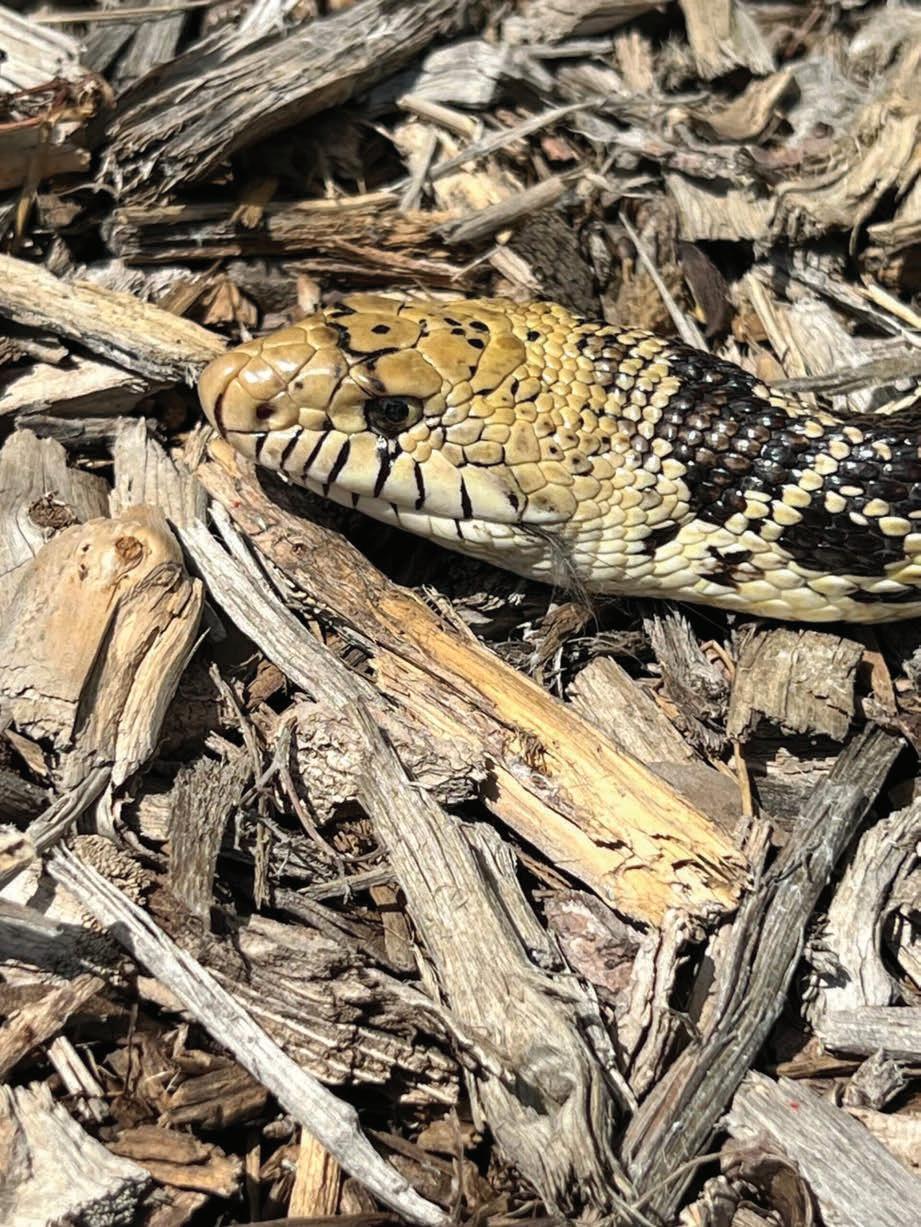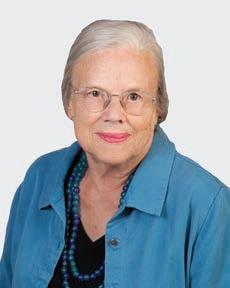
6 minute read
Gardens hold flowers, trees, wildlife
The latest Hudson Gardens Newsletter carries a photo of a resident bullsnake that may be found sunning itself in the gardens these days. is bullsnake is non-venomous, but really might resemble a rattler. Spring owering trees are in bloom and a variety of owers. Walk along trails and look for birds. Open free from sunrise to sunset. Pack a picnic and visit! Please observe wildlife from a distance. e Hudson Gardens & Event Center is located at 6115 S. Santa Fe Drive in Littleton. See hudsongardens.org.
Art in the park
Greenwood Village o ers art projects for kids ages 6-12 from 10 a.m. to noon Tuesdays, Wednesdays, ursdays at Wetlands Park, 5701 S. Quebec St. $35 per program. Limited to 20 participants. Call 303-797-1779. See tinyurl.com/gvparkart.
Green Mountain Falls
Green Mountain Falls Arts Festival is open with ve new art installations on June 30. ey are: “Open Skies” by Brenda Biondo; “EARTH. SPEAKS” by brooke smiley; “Skye” by Brian Wall; “ e Managers” by Molly Rideout; “Ovum” by Nikki Pike. Green Mountain Falls is at the foot of Pikes Peak. See tinyurl.com/artgmf.
Depot Art Gallery e Depot Art Gallery has its 61st Anniversary Show exhibited until July 10, followed by “Being Human” from July 11 to Aug. 5. e annual “Best of Colorado” will run Aug. 8 to Sept. 10, during Western Welcome Week and after. e gallery is at 2069 W. Powers Ave. in Littleton. See depotartgallery.org.

Denver Art Museum e Denver Art Museum will host its rst “Lowrider Show and Shine” on July 9, followed by the “Desert Rider: Dreaming in Motion” exhibit, through Sept. 24. e museum is at 14th and Broadway in Denver. See denverartmuseum.org.
Auditions
Town Hall Arts Center, 2450 W.
So in that moment I re ected on my own need for speed. Although I can’t slow down advancements in technology that are designed to speed things up, nor can I or should I worry about others and their need for speed, I can decide when it’s time to slow things down for myself. Can my walks along the shoreline be a little slower so I can appreciate the sounds of the waves lapping against the sand, taking in the salt air, and maybe nding a unique
Main St., Littleton, will be holding auditions July 8 from 10 a.m. to 4 p.m. for “All Shook Up.” Callbacks will be July 9. 303-7942787, townhallartscenter.org.
Opera
Denver Lyric Opera announces that tenor Mark Van Arsdale will be guest artist at the annual Summer Party, “Vive Le France,” from noon to 2 p.m. at Columbine Country Club, 17 Fairway Lane in Columbine Valley. Dr. Jeremy Reger will accompany. Tickets cost $75 and will be available June 25 online at denverlyricoperaguild.org. DLO raises money to support young singers who are starting a career in opera.

Fort Garland
“bu alo soldiers: reVision” is a new exhibit opening June 24 from 10-11:30 a.m. at Fort Garland Museum and Cultural Center. Eight independent artists have collaborated and worked independently to create this exhibit. Black Army recruits were known as Bu alo Soldiers. John Taylor Valdez, a descendent to John Taylor and Kitty Cloud (Ute), will appear. Fort Garland is in Colorado’s San Luis Valley. See historycolorado.org/fort-garland-museumcultural-center.
Castle Rock author Castle Rock author Amanda McCoy Flanagan’a new book, “Trust Yourself to Be All In: Safe to Love and Ley Go,” is available at amazon. com.

Denver Center shell or piece of sea glass? Can my hikes in the mountains be slowed down just a bit so I can take in the wildflowers, watch the streams rushing down the mountainside, or look out at the amazing vistas from the openings through the trees?
DCPA eatre tickets are available for the new season: “A Little Night Music”; “Clyde’s”; “Cebollas”; “Rubicon”; “Emma”; “ e Lehman Trilogy”; “Where Did We Sit On the Bus?” denvercenter.org, 303-8936030.
We are definitely a society on the go. We want the speed limits to be higher, our flights to get us to our destination faster. We want our meals delivered to our homes or tables in unreasonably fast times. We expect the elevator to show up as soon as we press the button. It’s the pace of the race these days that we are trying to keep up with and the pace is getting quicker and quicker each day.
I thought about the snail again. And as I did, I was reminded that moving at a snail’s pace is okay sometimes. I enjoy a slow brewing pot of coffee as it fills the kitchen with that beautiful coffee aroma. I love reading and spending time slowly letting the story develop and not racing to finish the book. I find it so much more meaningful to pray slowly as it connects me at a deeper level to those I am praying for and to my faith. And when I can slow down enough before rushing out of the house to write notes to my family and leave them around the house, it makes everyone feel so loved and appreciated. Is it time to slow down a bit for you? Are you running a race that just gets faster and faster all the time? I would love to hear your story at gotonorton@gmail.com, and when we can move at a snail’s pace sometimes, it really will be a better than good life.
Michael Norton is an author, a personal and professional coach, consultant, trainer, encourager and motivator of individuals and businesses, working with organizations and associations across multiple industries.

BY LUKE ZARZECKI LZARZECKI@COLORADOCOMMUNITYMEDIA.COM
The brain is overrated, according to Kadam Lucy James at the Kadampa Meditation Center.
“Have you ever felt peaceful in your head?” she asked.
She put her hands over her heart and said that’s where the mind is, adding that while the brain has conceptual reality, the mind exists in the heart, where we feel peace, love, joy and wisdom.
“If we can get into our heart, we automatically start to feel more peaceful,” she said.
James is temporarily living in Arvada and teaches meditation at the Kadampa Meditation Center. She started practicing about 41 years ago after she saw a “very peaceful person” in college.
“He was a student meditating on the end of his bed and I asked him what he was doing, because this was back in 1981, and meditation, no one had heard of back then,” she said.
Ever since, she’s been practicing and has taught all around the world, including England, San Francisco, New York City and now Denver. She hopes to one day achieve enlightenment, or in nite happiness and peace.
It takes a lot of hard work, but she said it’s the only thing where the more she does it, the happier she is.
It’s because, with meditation, the mind becomes naturally peaceful. Each person has a natural source of peace and happiness inside them, she said, and instead of seeking it elsewhere — relationships, ful lling jobs or material things — it’s already inside the body waiting to be found. e evidence lies in the random moments of peace and happiness everyone feels. It could be a torrential downpour and the mind is peaceful, settled and calm. e rst step to unlocking that potential and happiness is to breathe.
“What those moments show is that our mind is ne. And then what unsettles the mind is actually all our uncontrolled thinking,” she said.
Coming from the teachings of the Buddha, she compared the mind to a vast ocean. e waves are turbulent while below them is a vast, in nite, calm place. Waves of anxiety and negative emotions distort the brain but below those waves rests an incredible sanity.
“When our mind is settled, when we can let go of our troubled thoughts, and our turbulent thoughts, uncontrolled thoughts, then we naturally feel good. We naturally feel peaceful and we start to get a sense of our potential and who we really are, which is this person who has limitless potential, limitless happiness,” James said.
Focus on the nostrils
Carol O’Dowd, a Trauma and Transition Psychotherapist and Spiritual Counselor assists her clients by meeting them where they are and o ering them acceptance through breathing.
“If you focus on your breath, you cannot simultaneously focus on all your internal dialogue. It cannot be done. e human brain is not wired that way,” O’Dowd said.
It creates a space between the thoughts. e stress and anxiety stored in the body don’t go away, but the practice of noticing the emotions and putting them on pause to breathe helps calm the body down.
Breathing is a function of the body that automatically happens all the time. Focusing on that breath, O’Dowd compared it to a spectrum. What happens when the body stops breathing — death — is one end and the other is when the body pays attention to the breath — peace.
“It can be as simple as just experiencing that ow of air, and in and out of your nostrils. If you can place your attention there, that’s giving yourself a mini vacation,” she said.
O’Dowd encourages her clients to practice treating uncontrolled thoughts like a salesperson trying to sell them. Instead of buying, make them sit in the corner and return to them in 20 minutes after taking time to check in with the body.
It can also let go of stress. Pain, like what the ngers feel after working at a computer all day, can be a physical manifestation of stress. Holding on to that stress can lead to other health conditions.
“It’s not rocket science,” she said.
Escape to reality
James said achieving enlightenment is extremely di cult, and while the teachings she studied laid out di erent steps and pathways, she simpli ed it down to three. e rst is focusing on the breath to relax. e second is identifying delusions.
A delusion can be jealousy, greed, competitiveness or other unpleasant thoughts. Most of the time, those thoughts aren’t controlled by the mind and enter the brain randomly. It’s the root









